Nem Rán is Northern Vietnam’s version of fried spring rolls—crisp rice paper shells with juicy, flavor-packed filling.
In this post, I’m sharing my go-to authentic recipe, the classic Hanoi dipping sauce, and my top tips for perfectly crispy, gluten-free (not explosive) rolls.
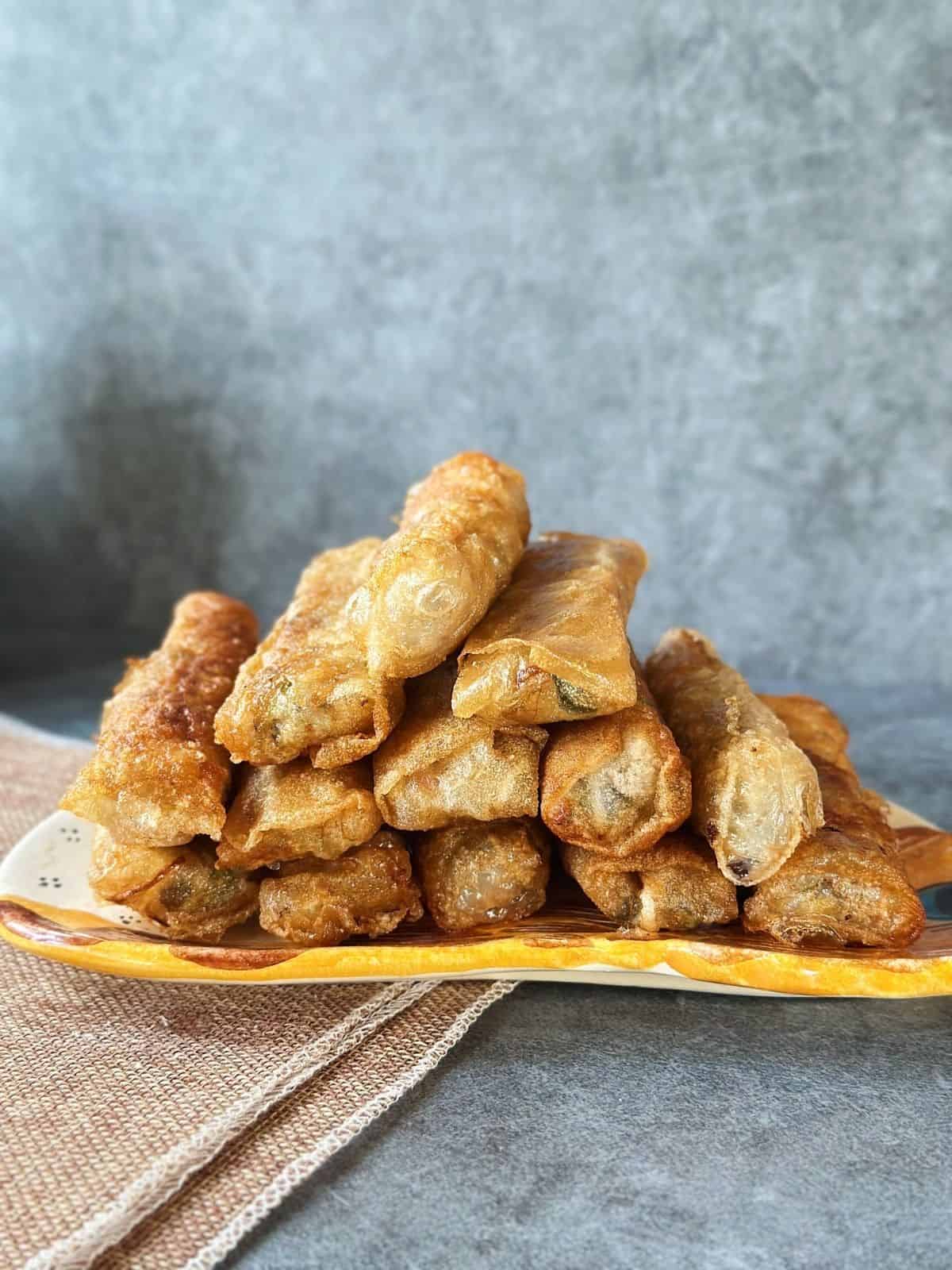
Nem Rán vs. Chả Giò: What’s the Real Difference?
You’ll often see online that Nem Rán and Chả Giò are just regional names for the same dish—Vietnamese fried spring rolls. But as a Vietnamese, I can tell you: they’re not identical twins. They share the same form, yes, but the flavor and texture are totally different.
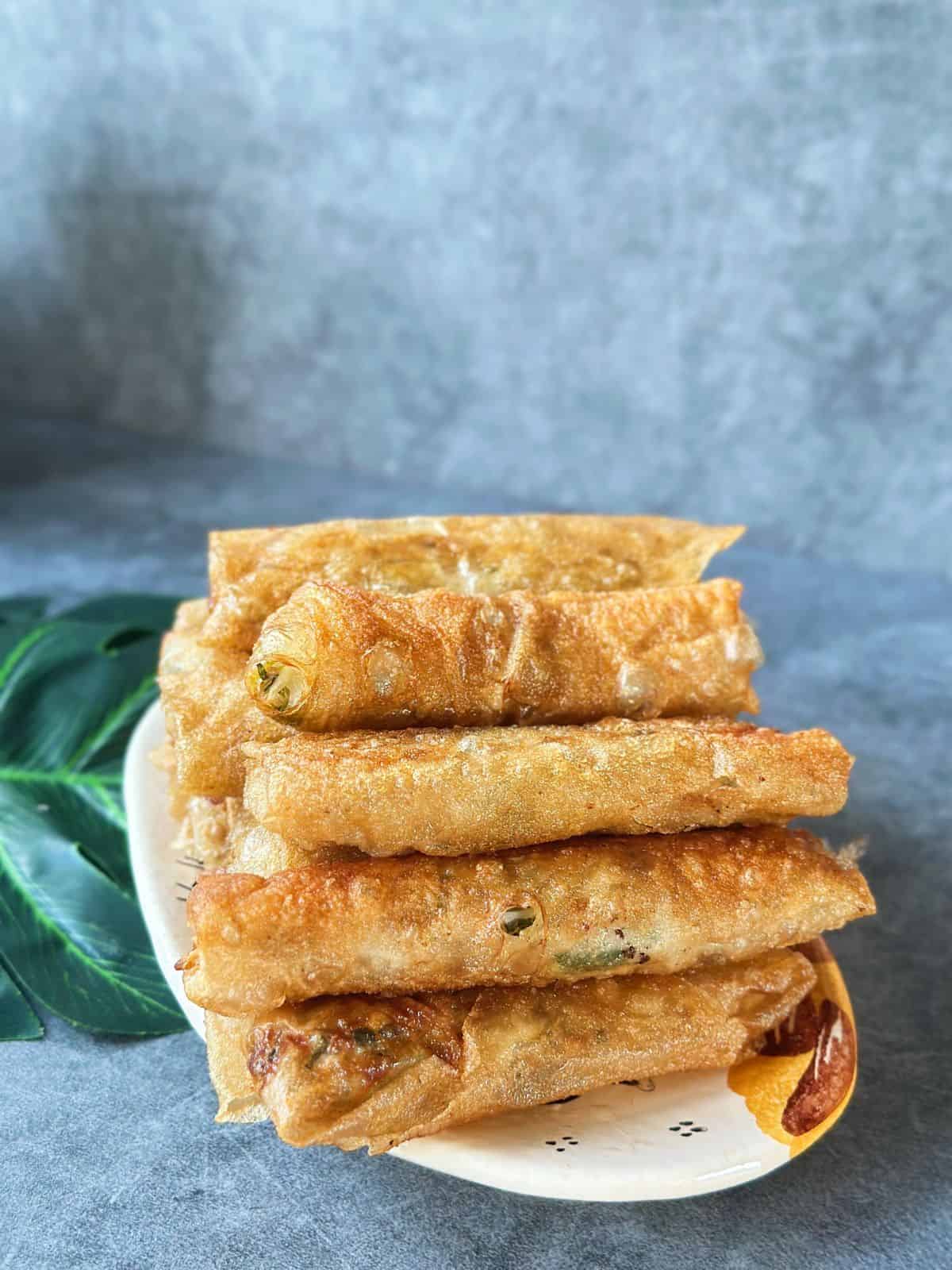
Nem Rán is the Northern version—wrapped in delicate rice paper and filled with a light, balanced mix of ground pork, crunchy veggies like kohlrabi, mung bean sprouts, or jicama. A touch of cilantro or Thai basil adds that refreshing, herby finish.

That’s why I never call Nem Rán “egg rolls.” They’re made with rice paper, not wheat wrappers.
I prefer calling them “fried spring rolls,” even though many people immediately picture fresh Gỏi Cuốn when they hear “Vietnamese spring rolls.”
Chả Giò, on the other hand, hails from the South. Down there, it can be wrapped in either rice paper or wheat wrappers (which Southerners call Bánh Tráng Bò Bía). This version is closer to the Vietnamese egg rolls you’ll find abroad.

The filling is richer too—southern aunties love sneaking in taro, sweet potato, or mung bean for extra body and sweetness.
The wheat wrapper variation actually shows a bit of Chinese-Vietnamese (Hoa people) influence, making it more like Chinese egg rolls or Filipino lumpia.
And fried rolls don’t stop there! In Vietnam, we have tons of creative takes:
Related Recipes | More tasty Hanoi recipes

(Northern-style Braised Pork & Eggs)
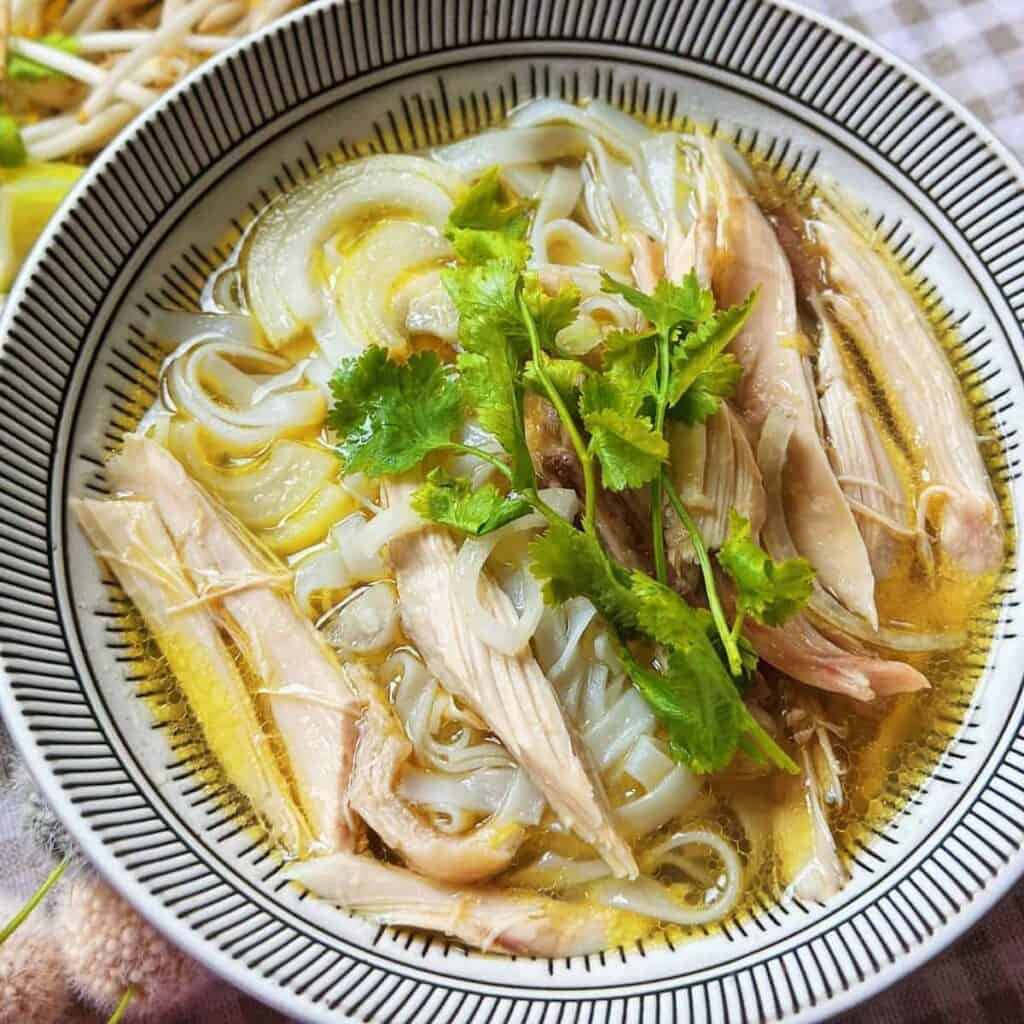
(Hanoi-style)

(Cà Phê Trứng)

(Cà Phê Sữa Đá)
Ingredients

Rice Papers – My Tips for Extra Crispiness
For the crispiest spring rolls, Vietnamese locals swear by rice papers made 100% from rice (no tapioca starch).
The famous ones are Bánh Đa Nem from Thổ Hà (Bắc Giang, North Vietnam) and Bánh Ram from Hà Tĩnh (Central Vietnam).
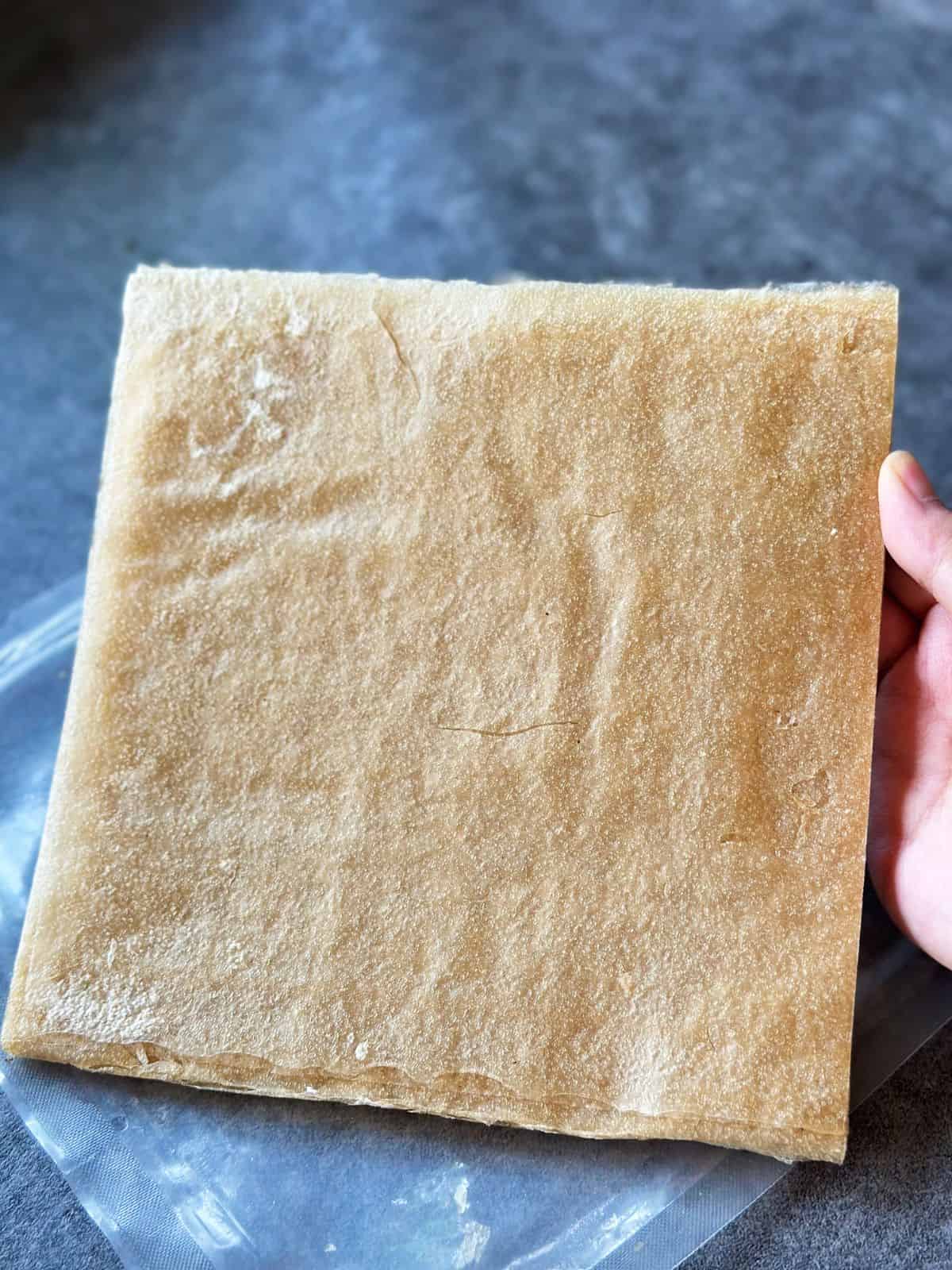

The downside is that pure rice papers are fragile and need to be kept frozen for long-term storage. That’s why they’re hard to find overseas. But if you ever spot them in a Vietnamese grocery store—don’t think twice, grab a few packs right away!
Most rice papers abroad contain tapioca starch, making them sturdier and shelf-stable at room temperature—but the trade-off is a slightly chewier texture and less crispiness after frying.
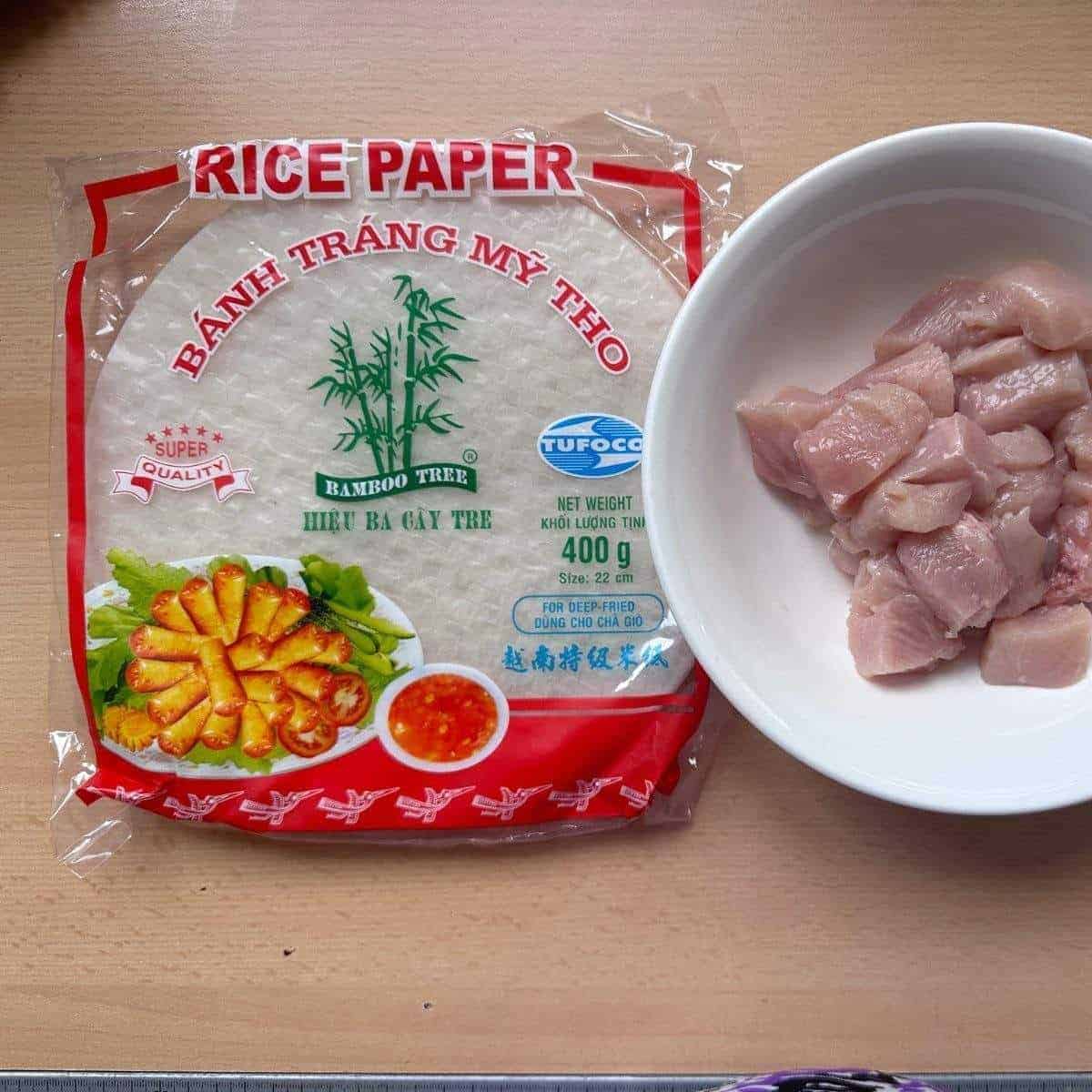
My go-to trick for these: after wrapping, lightly coat each roll in a mix of water, flour (or rice flour for gluten-free), and a pinch of baking powder before frying.
The flour mixture helps them crisp up beautifully, and the baking powder adds that golden, blistered crunch thanks to the Maillard effect.
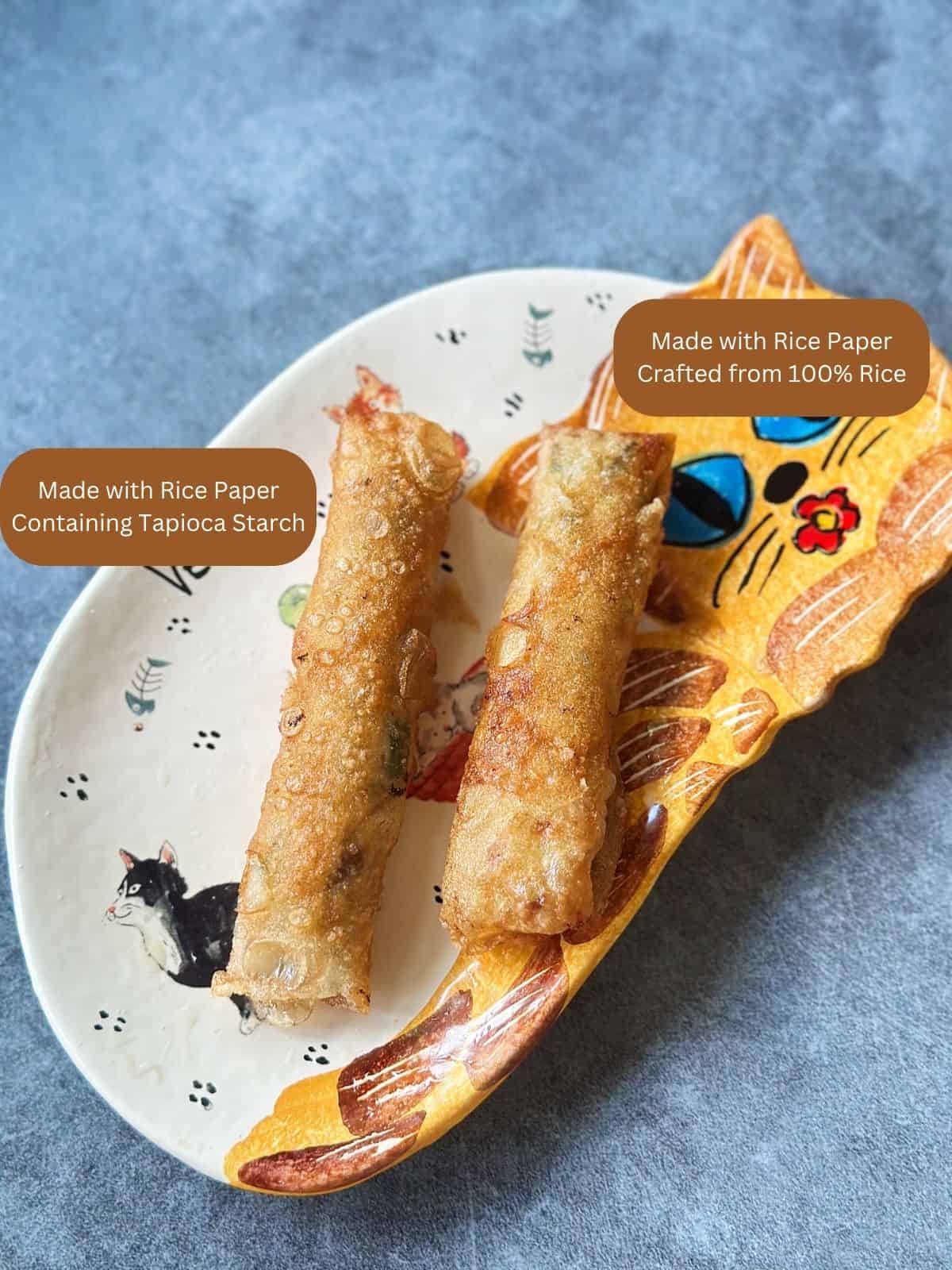
Filling

I like to think of the filling in three groups:
Group 1 – The Essentials
Ground pork: the hearty base of the filling.
Veggies: choose from mung bean sprouts, jicama, kohlrabi, carrots, or onions. I usually go with bean sprouts—or bean sprouts with a touch of carrot. I love bean sprouts because they’re quick to prep and don’t need shredding.
Egg yolk: Helps bind everything together. Save the egg white for sealing the rolls.
Seasoning: a simple mix of chicken powder, salt, and sugar for balance.
Ratio: use 2 parts ground pork to 1 part vegetables (by weight).
Group 2 – For Texture
Bean threads: add a soft, springy bite.
Wood ear mushrooms: bring a pleasant crunch and earthy depth.
Group 3 – For Aroma
Shallots: finely chopped, or use fried shallots for an extra boost of fragrance.
Green onions: add a mild, savory note.
Thai basil (optional): my go-to for that fresh, herby lift (cilantro works too if that’s what you have).
Dipping Sauce – The Game-Changer
If you’re in a hurry, sweet chili sauce or even Nuoc Cham will do the trick.
But if you want that true taste of Hanoi, go for the Northern-style dipping fish sauce—it’s the real deal. You’ll need:
Fish sauce: the soul of Vietnamese cooking
Kohlrabi / green papaya / cucumber + carrot: for a refreshing crunch
Salt: to season the veggies
Vinegar and sugar: to balance tang and sweetness
Chili and garlic: for heat and aroma
A sprinkle of black pepper: for a warm finishing note
Instructions
Step 1 – Make the Filling
- Soak the dry ingredients: Place the wood ear mushrooms and bean thread noodles in warm water. Soak just until the noodles soften – don’t let them drink up too much water or they’ll turn soggy later.
- Prep the veggies: Prep the veggies: Cut mung bean sprouts into 1.5 cm (about ½ inch) pieces. If you’re using kohlrabi or jicama, julienne them and give them a gentle squeeze to remove excess moisture.
- Chop and cut: Julienne the carrots, finely chop Thai basil (or cilantro) and green onion, slice the soaked mushrooms, and cut the noodles into 1-inch (3 cm) pieces.
- Mix the vegetables: In a large bowl, combine mung bean sprouts, carrots, Thai basil (cilantro), green onion, wood ear mushrooms, bean thread noodles, and fried shallots. Toss gently.
- Season the meat: In another bowl, mix ground pork with the egg yolk and all your seasonings until well blended.
- Combine everything: Add the meat mixture to the vegetable bowl and gently mix everything together.
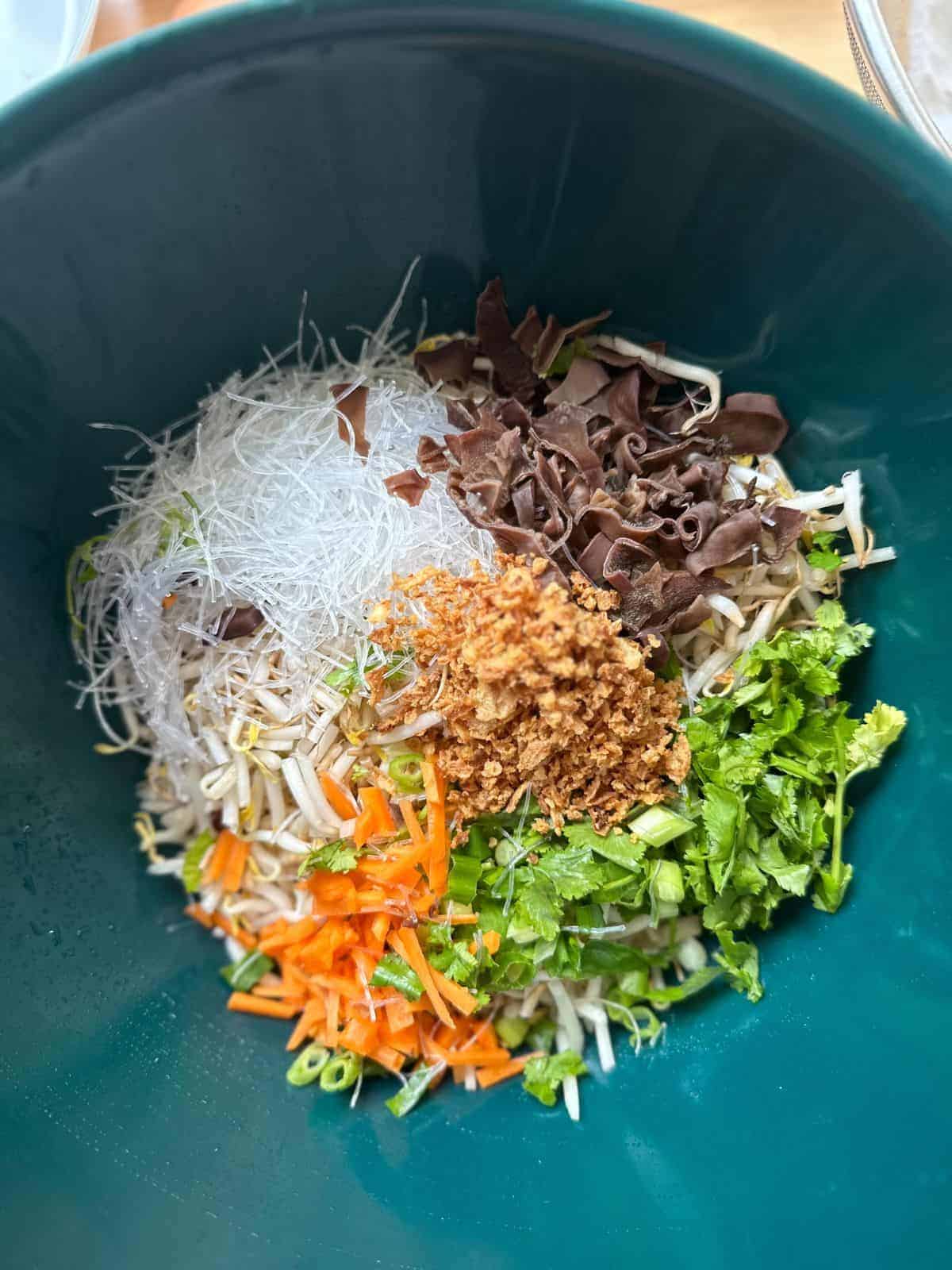
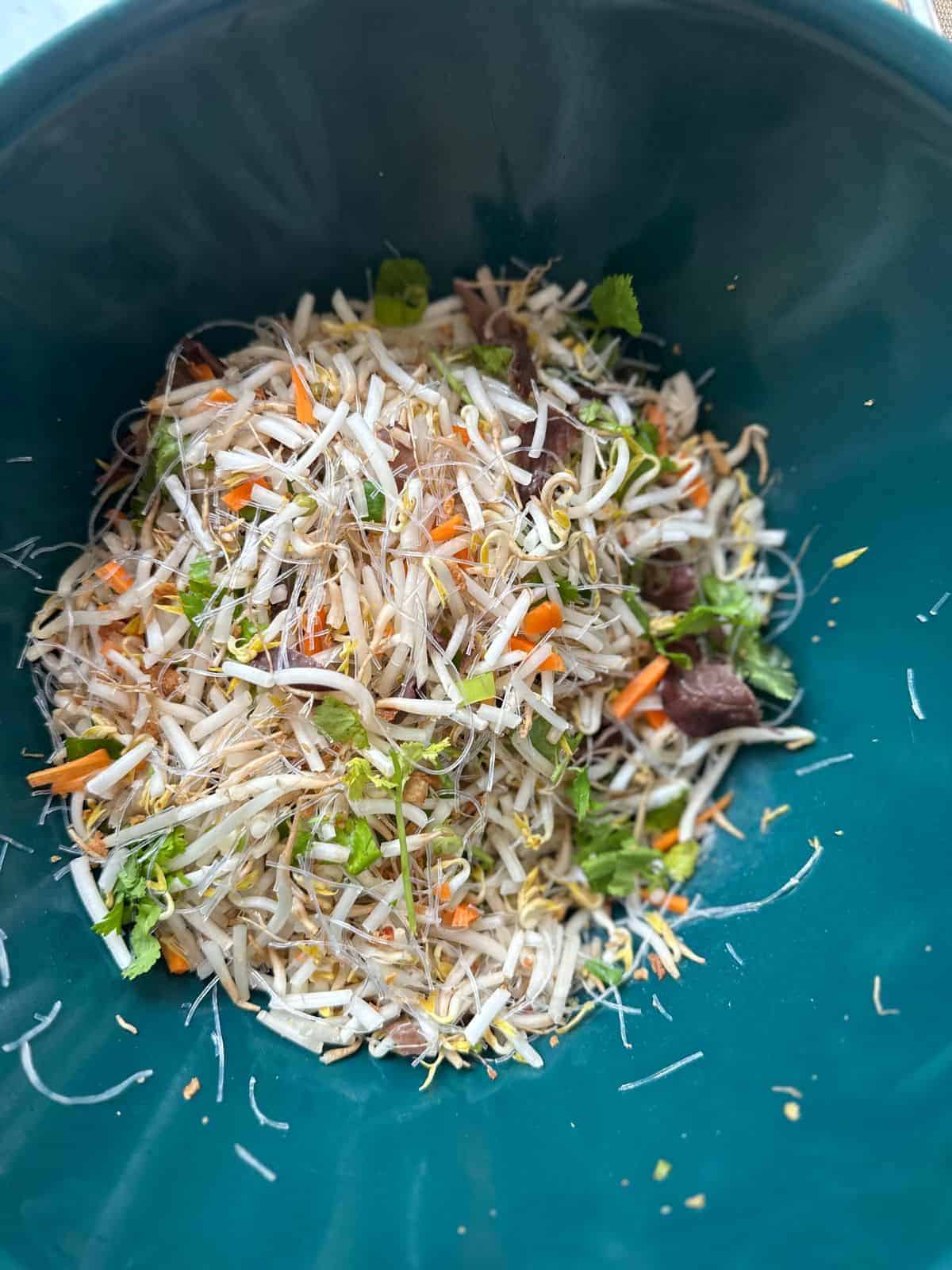

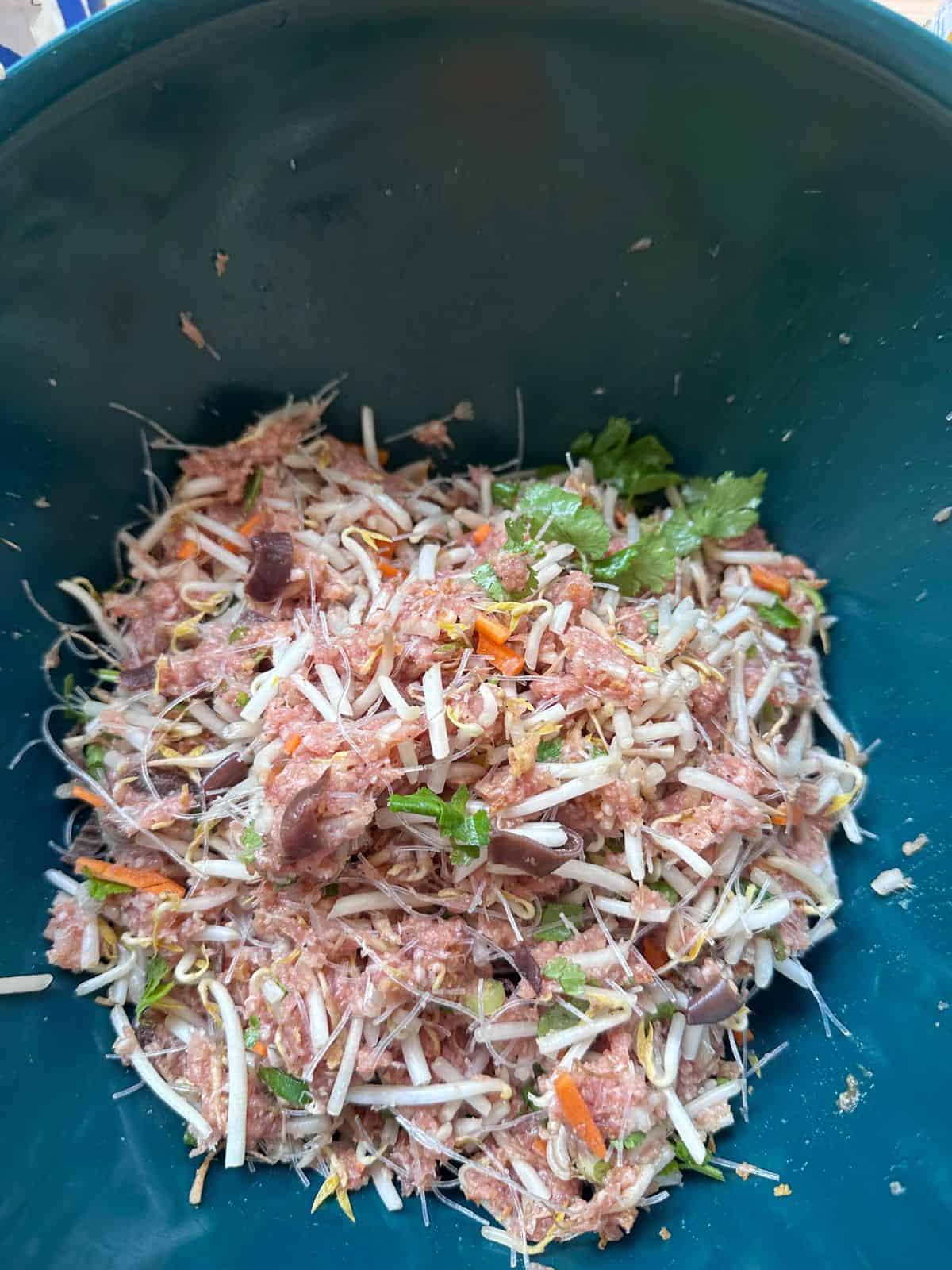
Step 2 – Wrap the Spring Rolls
- Prepare the Wrapper: Lightly moisten the rice paper with water to make it pliable.
- If you’re using round rice paper, place it flat on a clean surface.
- If you’re using a square wrapper, place it on the surface (or cutting board) with one corner pointing toward you so it forms a diamond shape.
- Add the Filling: Spoon about 2 tbsps filling onto the lower third of the round wrapper, or just below the center of the square one. Shape it into a short, even log (about 3–4 inches / 7.5–8 cm long).
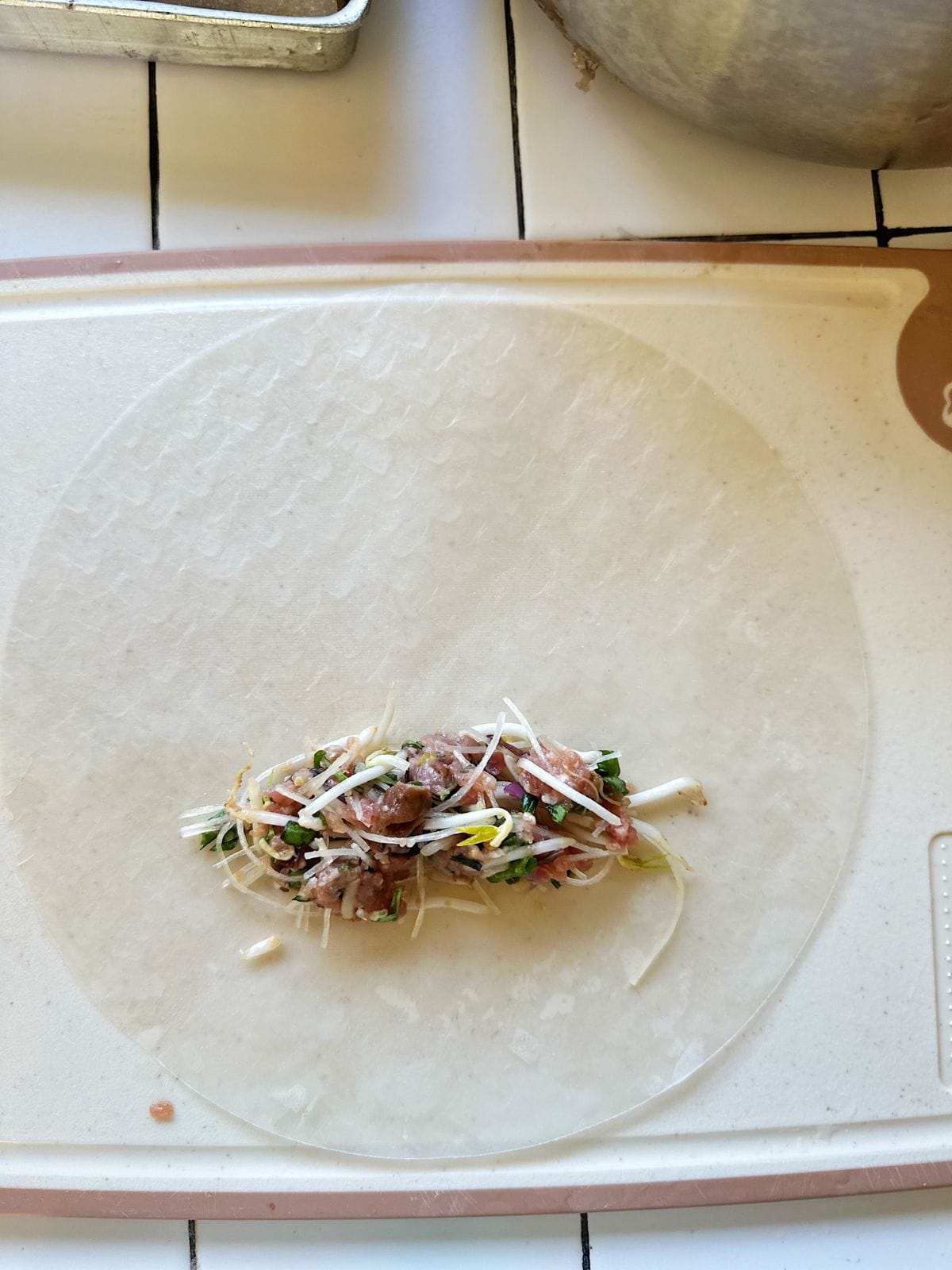
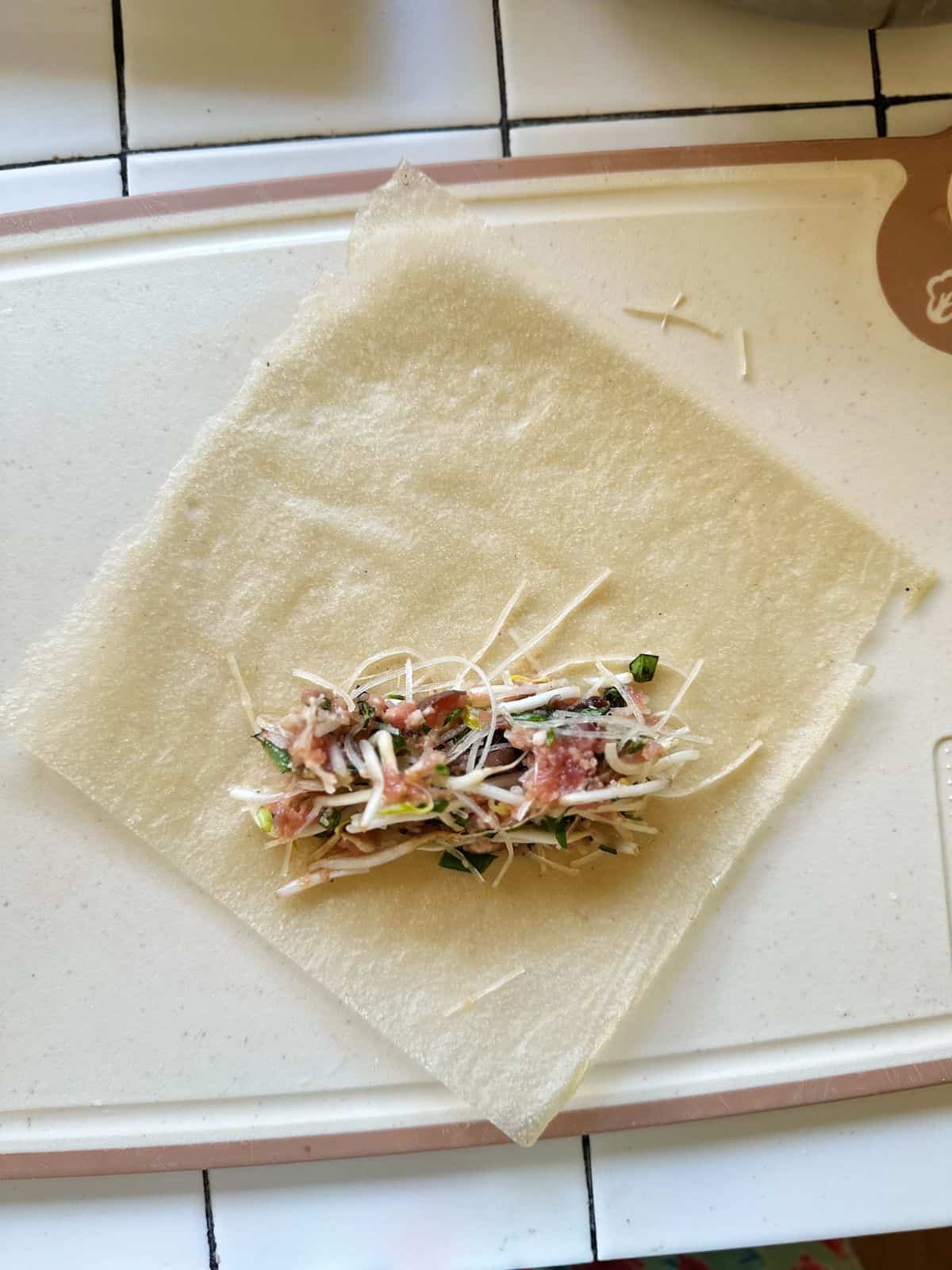
- Fold the Bottom: Lift the bottom corner and fold it tightly over the filling, tucking it in gently to keep everything snug.
- Fold the Sides: Fold the left and right corners toward the center, keeping the roll tight but not too firm to avoid tearing.
- Roll and Seal: Roll the wrapper away from you until only the top corner remains. Brush a bit of beaten egg white along the edge, then roll it up completely to seal.
- Repeat: Continue until all the filling is wrapped. Place the rolls seam side down to prevent unrolling.
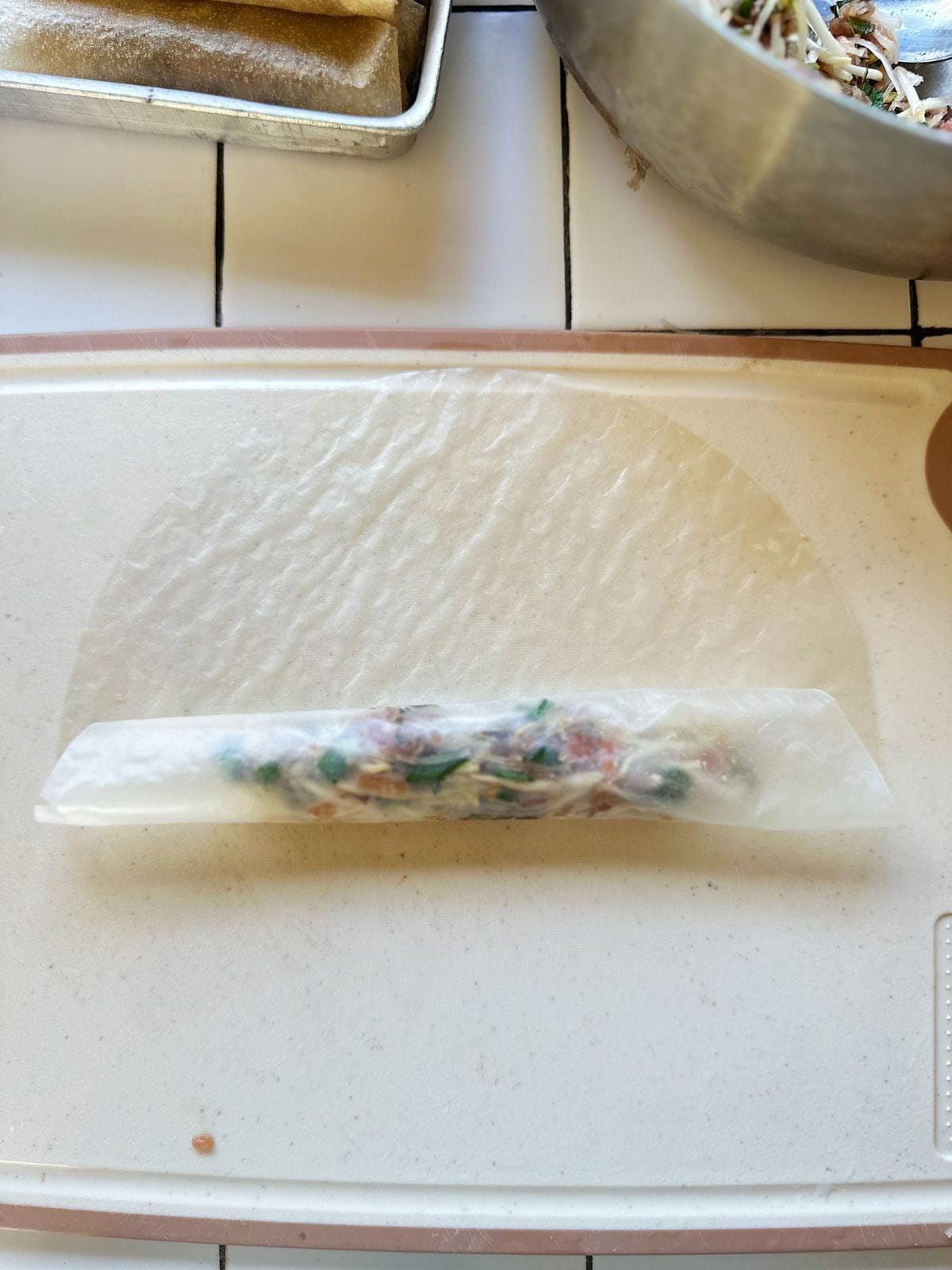
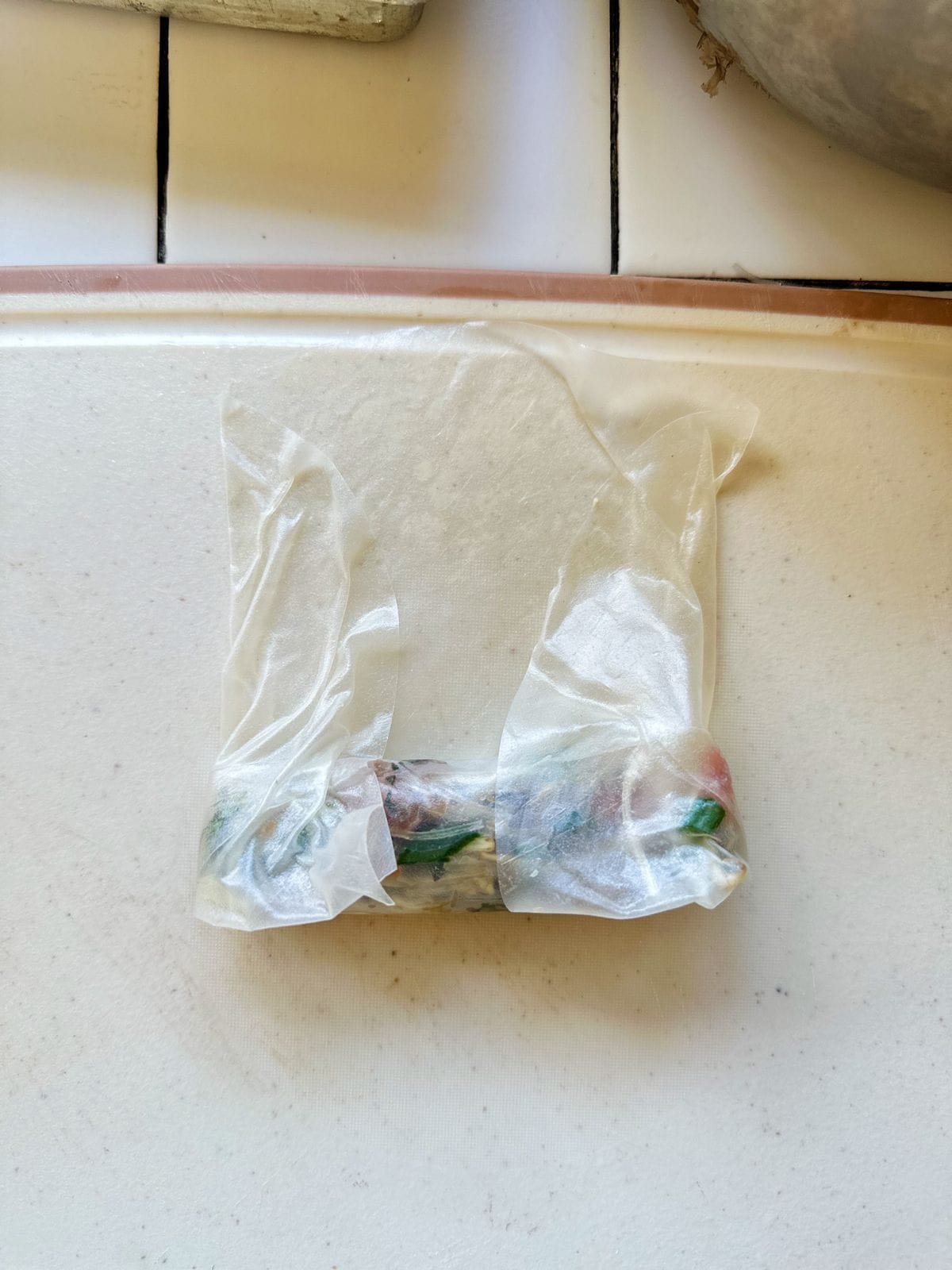
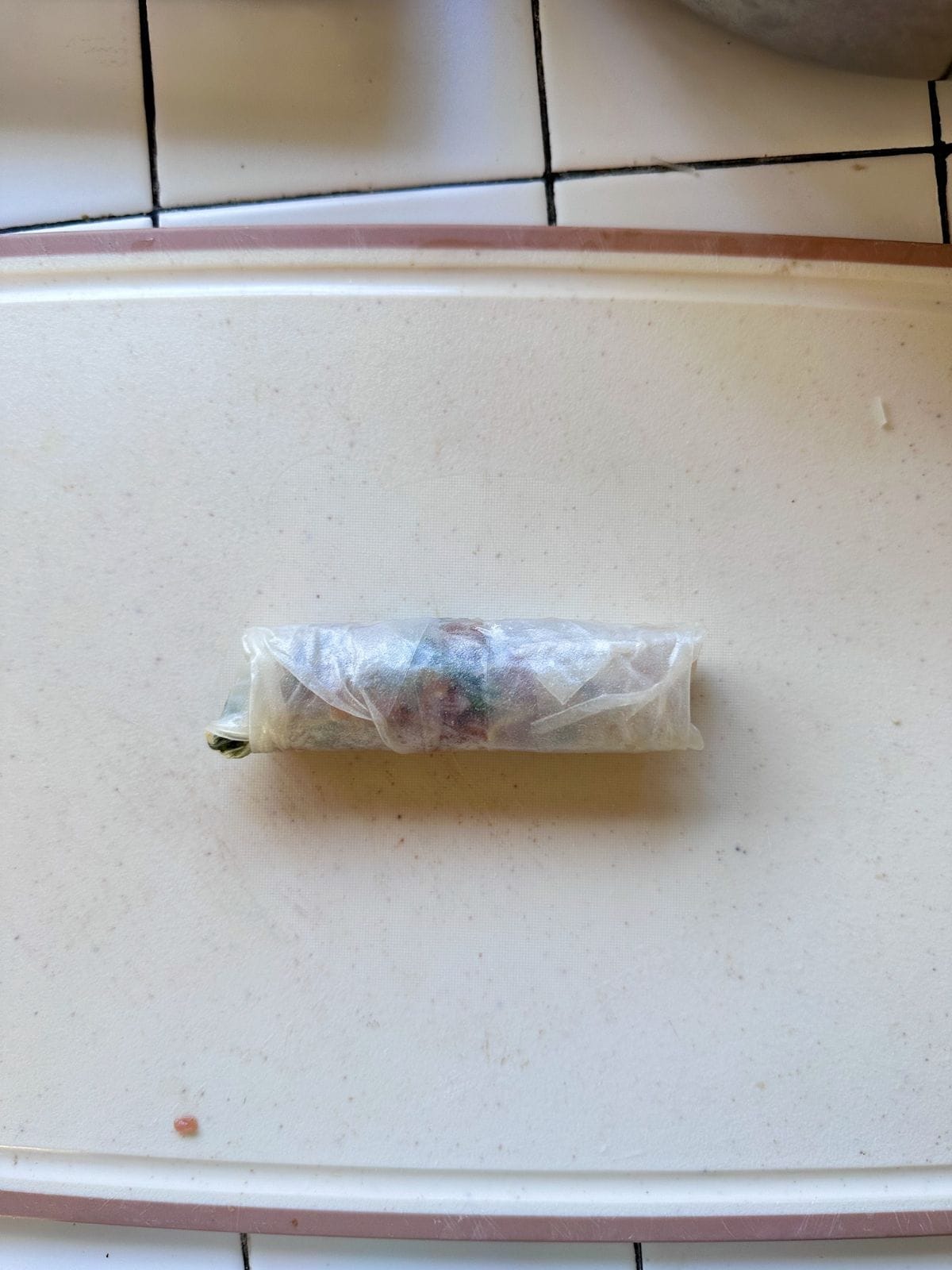
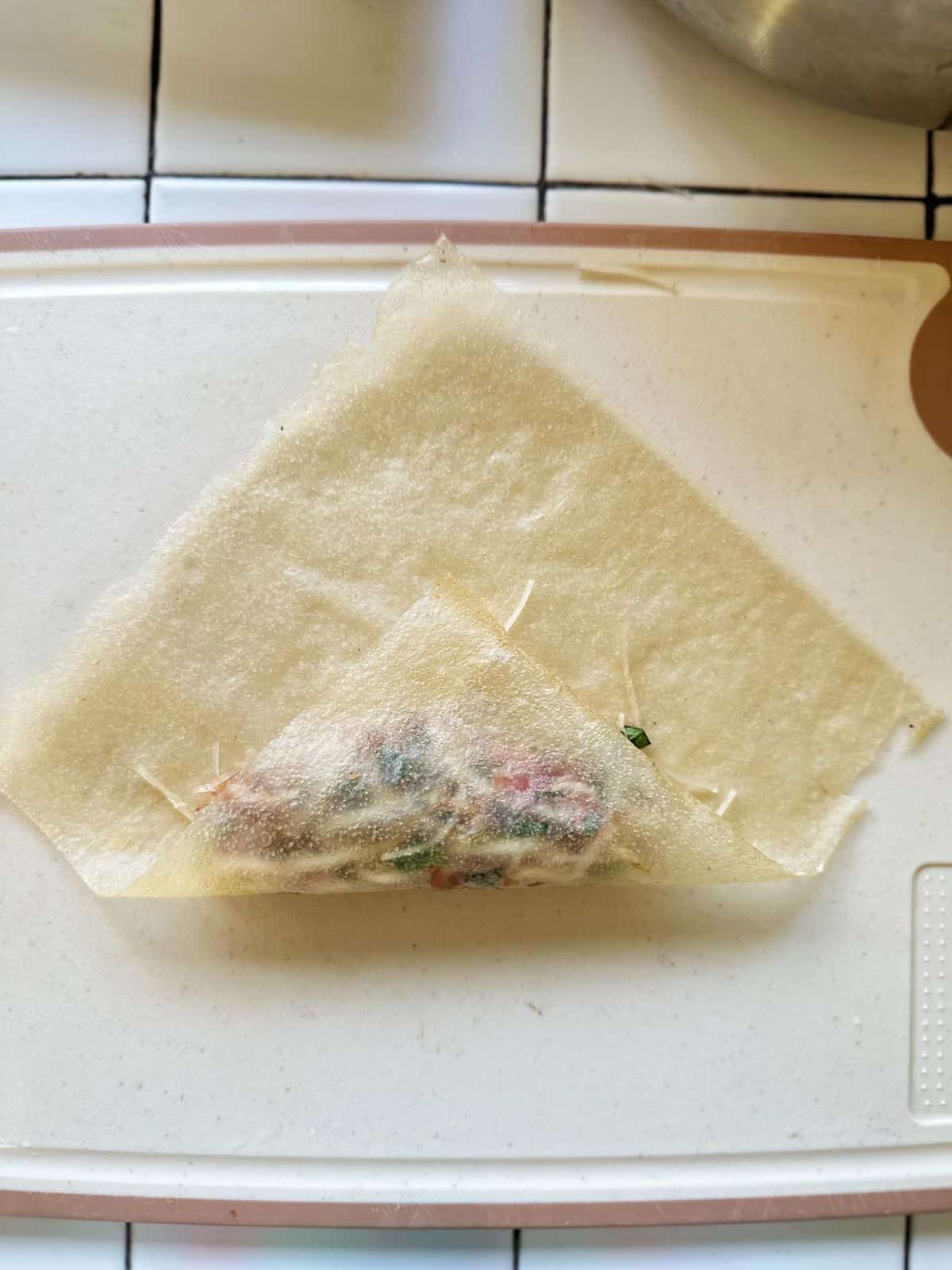
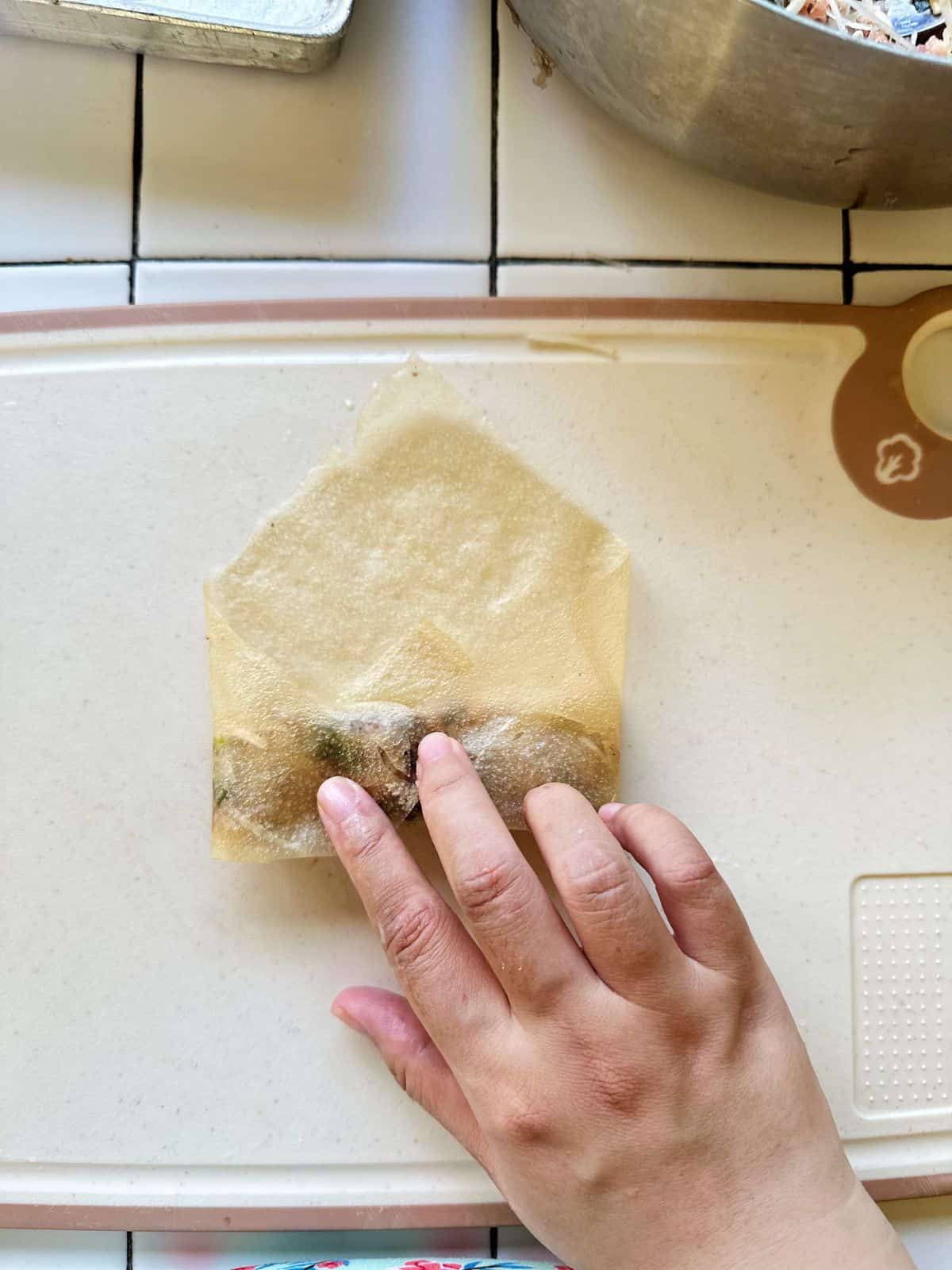
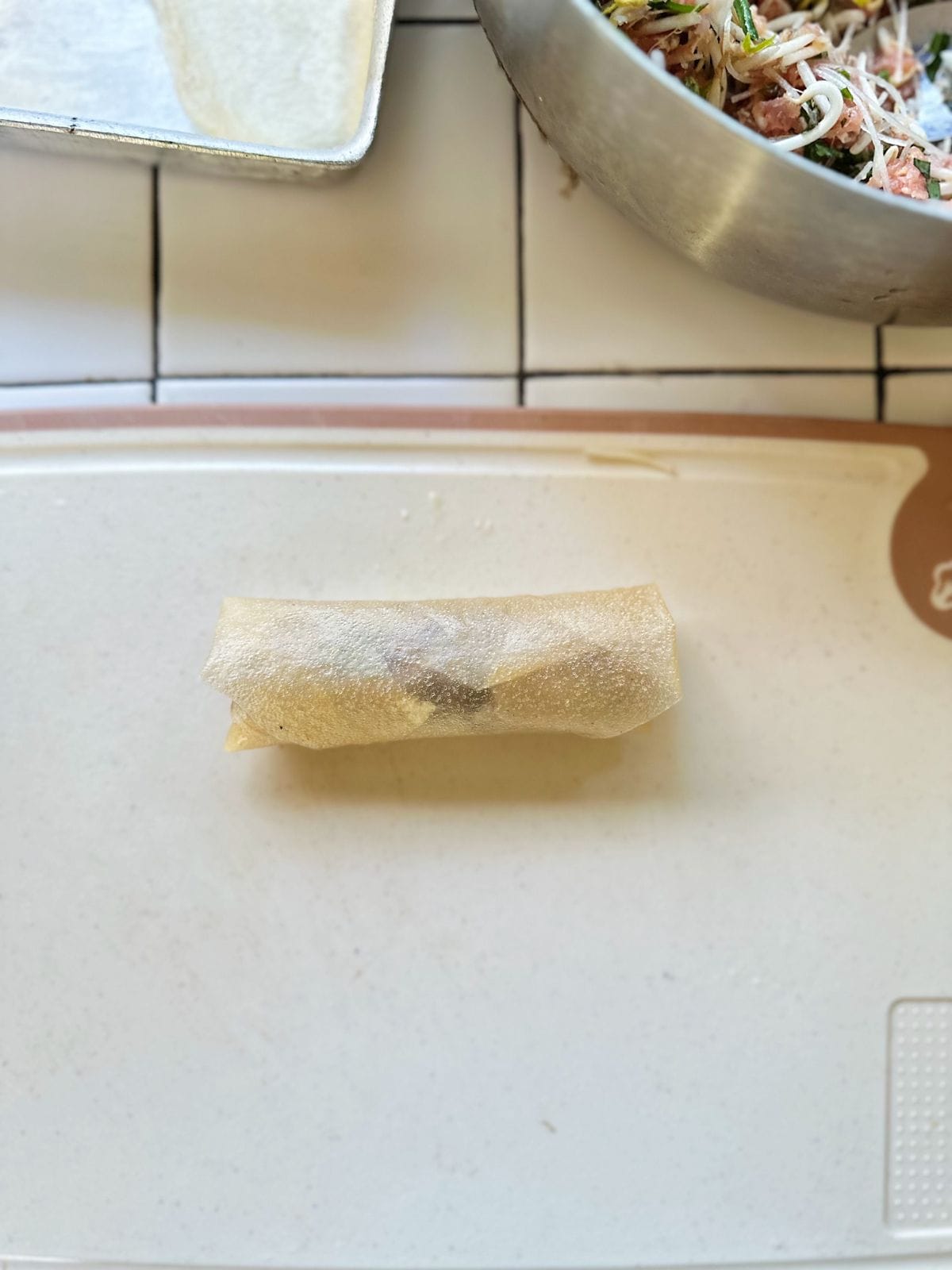
Step 3 – Fry the Spring Rolls
- Make the coating: Mix flour (or rice flour), baking powder, and water into a thin paste. If your rice paper contains tapioca starch (check the ingredient list), lightly coat each wrapped roll with this paste and let them dry a bit on a rack—this helps them crisp up beautifully.
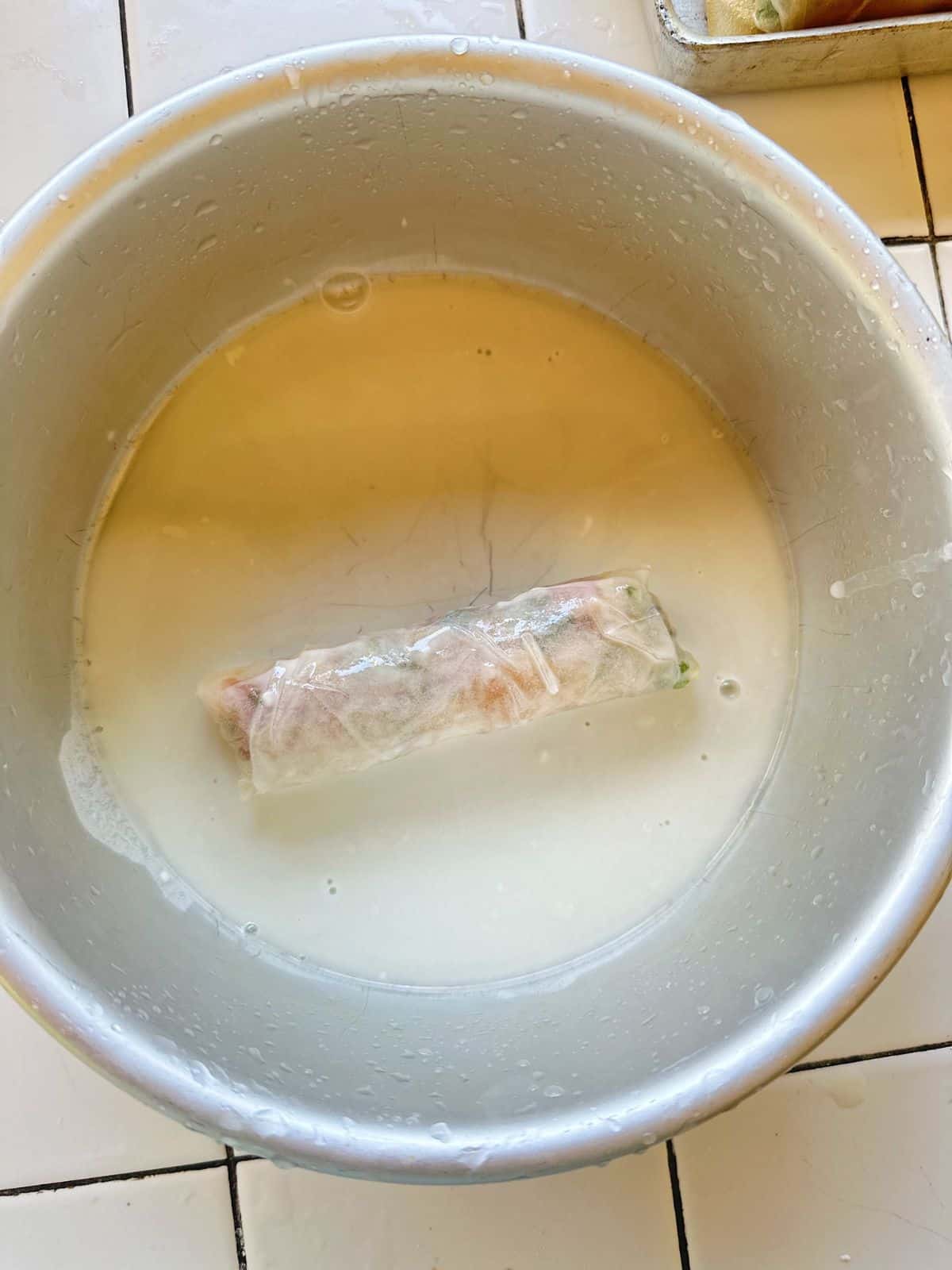
- First Fry: Heat enough oil in a pan to submerge at least half of each roll. Fry over medium-low heat until the rolls turn light golden. Remove and let them cool on a rack or strainer to drain excess oil.
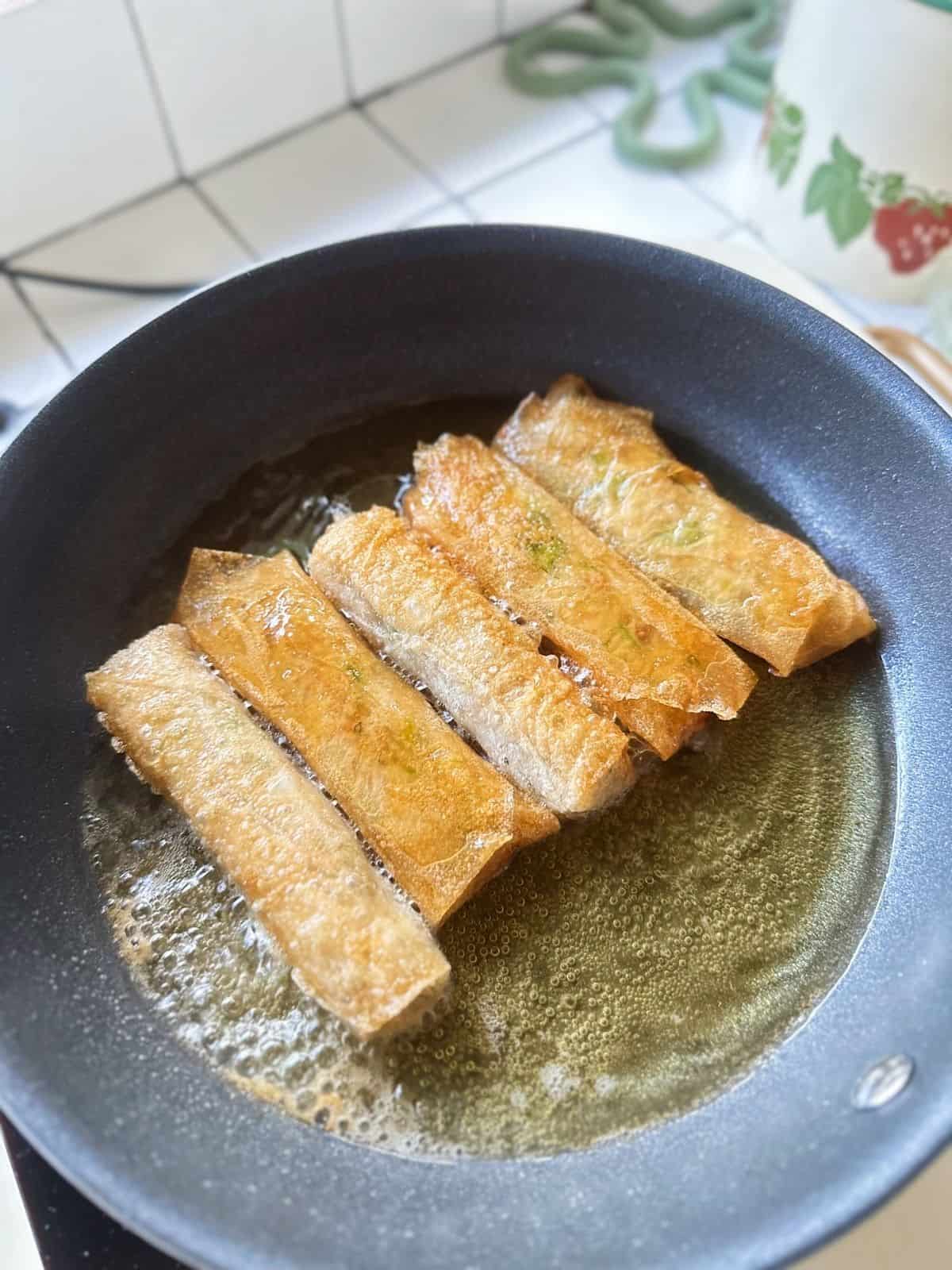
- Second Fry (optional): You’ve got two options.
- Deep-fry again over high heat until perfectly crispy and golden brown.
- Air-fry at 390°F (200°C) for about 10 minutes — my favorite method for less oil and an amazing crisp!
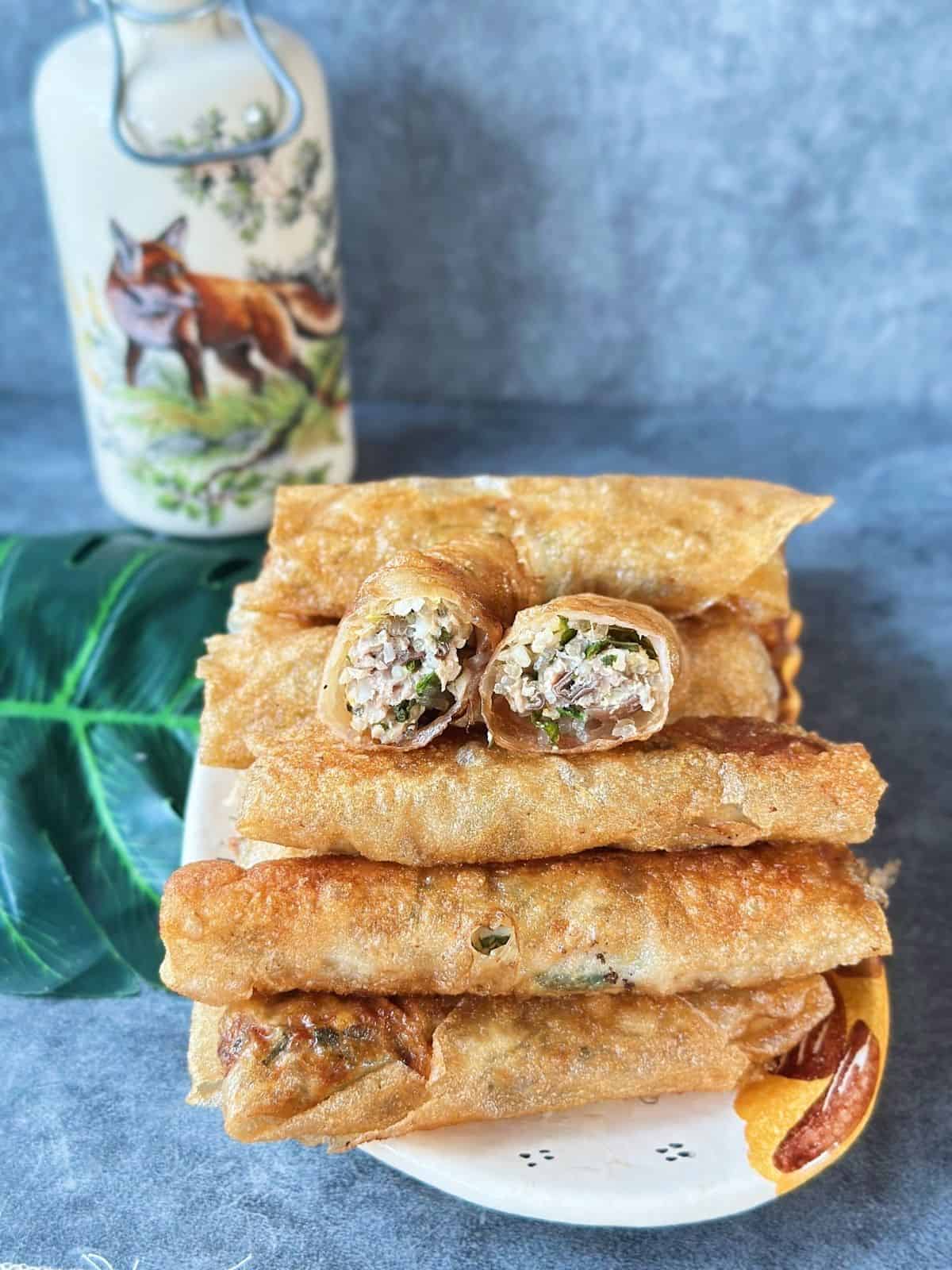
Step 4 – Make the Dipping Sauce
- Prep the veggies: Peel and thinly slice the carrot and kohlrabi.
- Quick pickle: Toss with salt and sugar, then let them sit for 15 minutes to draw out water.
- Mix the sauce: In a separate bowl, mix fish sauce, sugar, vinegar, chili, garlic, and black pepper.
- Combine: Add the drained carrot and kohlrabi to the sauce and stir well.


Expert Tips
Choose the Right Wrapper
- For the crispiest texture: Use rice paper made from 100% rice (no tapioca). These give a light, crackly crunch when fried.
- If using tapioca-blended rice paper, lightly coat the wrapped rolls in a thin flour-water (or rice flour-water) batter before frying to keep them crisp longer.
Keep the Filling Dry
- For the filling, keep a 2:1 ratio — two parts protein (ground pork, shrimp, crab meat…) to one part vegetables (by weight) for the best balance of flavor and texture.
- Squeeze out excess moisture from veggies like carrots, jicama, or mushrooms.
- Avoid over-soaking noodles and don’t add too much liquid seasoning — moisture makes the rolls soggy and causes oil splatters.
Wrap Tightly (but Not Too Tight)
- Roll the wrapper snugly to avoid air pockets, but don’t pack it too tight — the filling needs space to expand when frying.
Fry Twice for the Best Crunch
- First fry: Cook over medium-low heat until light golden. Remove and let cool.
- Second fry: Re-fry at high heat to get that beautiful, shattering crisp texture.
- You can also air-fry at 200°C (390°F) for 8–10 minutes for a lighter version.
Rest on a Rack, Not Paper Towels
- Let the fried rolls rest on a wire rack so air can circulate and keep them crispy.
- Paper towels trap steam and make the rolls soggy.
How to Store Spring Rolls
Option 1 – Half-fry before freezing:
Fry the spring rolls once until light golden, let them cool completely, then freeze them individually (so they don’t stick). When ready to enjoy, simply refry or air-fry until golden and crisp again.
Option 2 – Freeze raw rolls:
You can also freeze them right after rolling. Arrange them in a single layer (or separate with baking paper) so they don’t stick together. Once completely frozen, you can transfer them into one container or bag.
When cooking, fry directly from frozen—no need to thaw! Just lower the heat slightly at first to ensure they cook evenly.
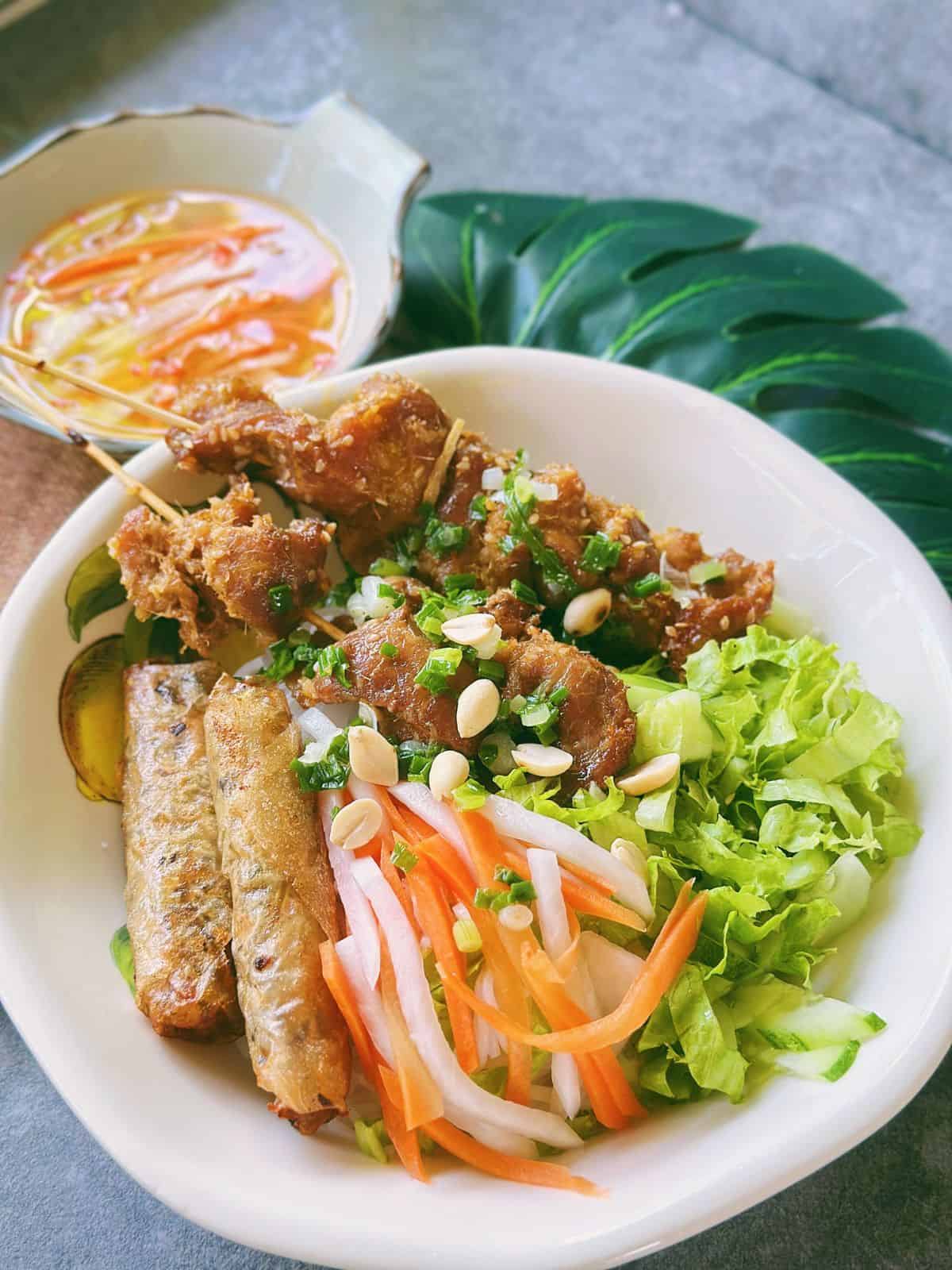
How to Serve Vietnamese Fried Spring Rolls
Bun Cha Gio (Rice Noodle Bowl):
Cut the fried rolls into bite-sized pieces and serve them over rice noodles with fresh herbs, lettuce, cucumber, pickled carrots & daikon, scallion oil, a sprinkle of roasted peanuts and a drizzle of Nuoc Cham sauce.
As a Snack or Appetizer:
In Vietnam, people love wrapping crispy spring rolls in lettuce leaves with fresh herbs, then dipping the whole bundle into Nuoc Cham — it’s crunchy, aromatic, and incredibly refreshing!
Bun Cha / Bun Thit Nuong Cha Gio:
Fried spring rolls also make the perfect companion for Vietnamese grilled pork and rice noodles — Bun Cha in the North or Bun Thit Nuong in the South.
More Recipes Straight from Vietnam

(Pork Meatball Noodle Soup)
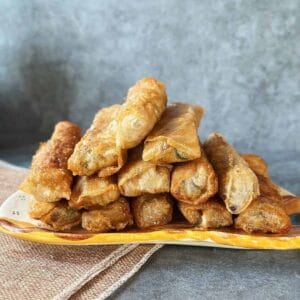
Vietnamese Fried Spring Rolls (Northern-style Nem Rán)
Equipment
- 2 Mixing bowls
- 1 Large plate
- 1 non-stick pan
Ingredients
- Rice Papers use 8.5-inch / 22 cm round rice papers or square rice papers
Flour batter
- 3 tbsp all-purpose flour or rice flour for gluten-free
- 1 tsp baking powder
- 5 tbsp water adjust for a thin, smooth consistency
For the filling
- 1.1 lb ground pork 500g
- 2 egg yolks reserve egg whites for sealing the rolls
- ½ tbsp chicken powder
- ½ tbsp salt
- ¼ tbsp sugar
- ½ lb mung bean sprouts 225g, cut into ½–1.5 inch (1–3 cm) pieces
- ⅓ medium-sized carrot about 25g, julienned
- 5 wood ear mushrooms about 5g, soaked and finely chopped
- 1 handful Thai basil or cilantro optional, for freshness
- 3 sprigs green onion finely chopped
- 1 oz bean thread noodles 30g, soaked and cut into shorter strands
- 2 tbsp minced or fried shallots
Hanoi-styled dipping sauce (optional)
- ½ bulb kohlrabi 3.5oz / 100g
- ⅔ medium-sized carrot 1.7oz / 50g
- ½ tsp salt for the pickled veggies
- 1 tbsp sugar for the pickled veggies
- 1 tbsp vinegar for the pickled veggies
- 1 tbsp fish sauce
- 5 tbsp water
- ¾ tbsp vinegar
- 1 tbsp sugar
- minced garlic to your taste
- minced chili to your taste
- black pepper powder to your taste
Instructions
Make the filling
- In one bowl, combine these ingredients: mung bean sprouts, carrots, cilantro, green onion, wood ear mushrooms, bean thread noodles, and shallots. Gently mix them until just incorporated.
- In another bowl, add the ground pork, egg yolk, and all the seasonings, thoroughly mixing them together.
- Finally, combine the meat mixture with the vegetable bowl and gently mix them together.
Wrap the Spring Rolls
- Lightly moisten the rice paper with water to make it pliable.– Round rice paper: place flat on a clean surface.– Square rice paper: place with one corner pointing toward you (diamond shape).
- Spoon about 2 tbsp of filling onto the lower third of the round wrapper, or just below the center of the square one. Shape it into a short log, about 3–4 in (7.5–8 cm) long.
- Lift the bottom corner and fold it tightly over the filling, tucking gently to keep it snug.
- Bring the left and right corners toward the center, keeping the roll tight but not too firm to avoid tearing.
- Roll the wrapper away from you until only the top corner remains. Brush with a little beaten egg white, then roll fully to seal.
- Continue wrapping all filling. Place rolls seam-side down to prevent unrolling.
Fry the Spring Rolls
- Prepare the Coating: Mix flour (or rice flour), baking powder, and water into a thin paste. If your rice paper contains tapioca starch, lightly coat each wrapped roll with this paste and let them rest on a rack to dry slightly—this helps achieve extra crispiness.
- First Fry: Heat enough oil in a pan to cover at least half of each roll. Fry over medium-low heat until light golden. Remove and drain on a rack or strainer.
- Second Fry (Optional):– Deep-fry: Return rolls to hot oil and fry until fully golden and crispy.– Air-fry: Place rolls in an air fryer at 390°F (200°C) for about 10 minutes for a lighter, yet crispy result.
Make the Dipping Sauce (optional)
- Peel and thinly slice the carrot and kohlrabi.
- Toss the carrot and kohlrabi with salt and sugar, then let them sit for 15 minutes.
- In a separate bowl, combine together fish sauce, sugar, vinegar, chili, garlic, and black pepper.
- Add the carrot and kohlrabi, drained of any brine, to the bowl of fish sauce.
- Now you can savor this dipping sauce with your spring rolls.



